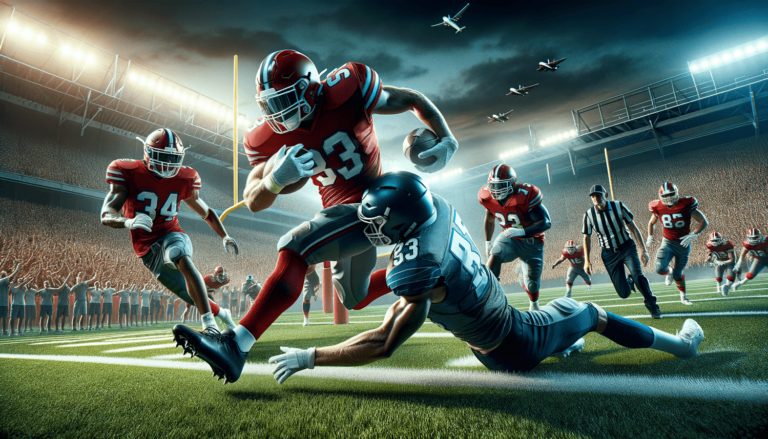
A chop block in football is an illegal maneuver where an offensive player blocks a defensive player below the waist, while the defensive player is already engaged with another blocker above the waist. This dangerous technique is prohibited as it poses a high risk of injury to the players involved.
Understanding Chop Block in Football
Chop block is a dangerous and illegal tactic in the game of football. It occurs when an offensive player blocks a defensive player below the waist, while the defensive player is already engaged with another blocker above the waist.
Why Chop Blocks Are Illegal
The primary reason for the prohibition of chop blocks is the high risk of injury associated with the technique. Players who fall prey to chop blocks can suffer severe knee and leg injuries. The NFL and other football organizations have taken firm measures to eliminate chop blocks from the game to ensure player safety and fair competition.
Identifying Chop Block During Gameplay
Understanding the chop block in football is essential for players, coaches, and referees alike. The chop block is recognized in the following situations:
- The defensive player is in a stationary position, and the offensive player strikes below the waist from the front, side, or back.
- The defensive player is engaged with a blocker above the waist, and another offensive player comes in to block at the knees or lower.
Penalties for Chop Block
Violations of the chop block rule come with penalties to deter any further use. In the NFL, a chop block infraction results in a 15-yard penalty against the offending team. College or high school football organizations may have their own specific penalties, but they all strive to maintain player safety by discouraging the use of chop blocks.
Training to Avoid Chop Blocks
Coaches must emphasize the importance of proper blocking techniques during practice sessions. Players should be trained to avoid engaging in chop blocks through drills and education on the consequences associated with such illegal tactics. Referees must also be diligent in identifying and penalizing chop blocks during gameplay, reinforcing the rule’s importance and contributing to the overall safety of the sport.
Understanding Types of Blocks in Football
To further grasp the concept of a chop block and why it’s considered illegal, it’s essential to understand other types of blocks employed in football. Some common legal blocks include:
- Drive Block: A fundamental technique where the offensive player pushes the defensive player in a direction to create a running lane.
- Reach Block: Engaging a defender who is positioned laterally to the blocker to clear a path for the ball carrier.
- Double Team Block: Two offensive players working together to block a single defensive player.
- Cut Block: A legal maneuver where a blocker engages a defender at thigh level or above, without any involvement of another offensive player.
By understanding the distinctions between legal and illegal blocking techniques, players can avoid chop blocks and focus on safer gameplay.
Significance of Offensive Line Techniques
Offensive linemen play a crucial role in creating openings for running backs and protecting the quarterback. Focusing on legal techniques while eliminating chop blocks from the game is critical for maintaining fluid offensive strategies that adhere to the rules and prioritize player safety. Players must put in the effort to perfect these legal techniques, optimizing their on-field performance and maintaining a fair competition.
Defensive Strategies Against Chop Blocks
Defensive players can adopt specific strategies to protect themselves against chop blocks. Developing proper fundamentals and techniques, such as maintaining balance and keeping the knees bent, can help counter the threat posed by chop blocks. Recognizing potential chop block situations and reacting accordingly can also minimize the risk of injury.
- Recognition: A defensive player should pay attention to his surroundings and watch for any approaching low blocks.
- Lateral Movement: Quick lateral movement can force the offensive player into a less advantageous position to execute a chop block.
- Hand Placement: Keeping the hands down in a ready position for potential contact can help push off or fend off a low block.
Adapting one’s defensive skills to counter possible chop blocks, while simultaneously combatting the illegal practice, is essential for maintaining player safety and ensuring a fair competition.
FAQ Section: Chop Blocks in Football
Now that you’re familiar with chop blocks and their implications on the game of football, explore some frequently asked questions on the subject to deepen your understanding and clarify any misconceptions.
What is the difference between a chop block and a cut block?
A chop block involves an offensive player blocking a defensive player below the waist, while the defensive player is already engaged with another blocker above the waist. A cut block, on the other hand, is a legal maneuver in which a single offensive player blocks a defensive player at thigh level or above, allowing for cleaner gameplay and significantly reducing the risk of injury.
Are cut blocks legal in football?
Yes, cut blocks are legal in football, provided that only one offensive player engages the defensive player at thigh level or above and no other offensive player is involved in the block. This strategy allows players to execute low blocks without endangering their opponents or violating game rules.
What happens in case of a chop block violation?
If a chop block violation occurs, the offending team is penalized with a 15-yard penalty in the NFL. However, penalty yardage may vary depending on the specific rules and regulations of college or high school football organizations. The intention behind these penalties is to discourage the use of chop blocks and to ensure player safety.
Is it easy for referees to spot a chop block during gameplay?
Identifying chop blocks can be challenging for referees, particularly in fast-paced gameplay situations. It requires a keen eye for detail and a deep understanding of the game’s rules regarding legal and illegal blocks. Despite these challenges, it is crucial for referees to be diligent in calling out chop block infractions to maintain player safety and deter future chop block violations.
How can coaches teach players to avoid chop blocks?
Coaches play a vital role in teaching players to avoid chop blocks by emphasizing the importance of proper blocking techniques during practice sessions. Players must be trained through drills and educated about the potential consequences of illegal tactics. As a result, players will adopt safer methods, ultimately contributing to cleaner gameplay and protecting player safety.
Featured Posts
- No pillar pages found.





